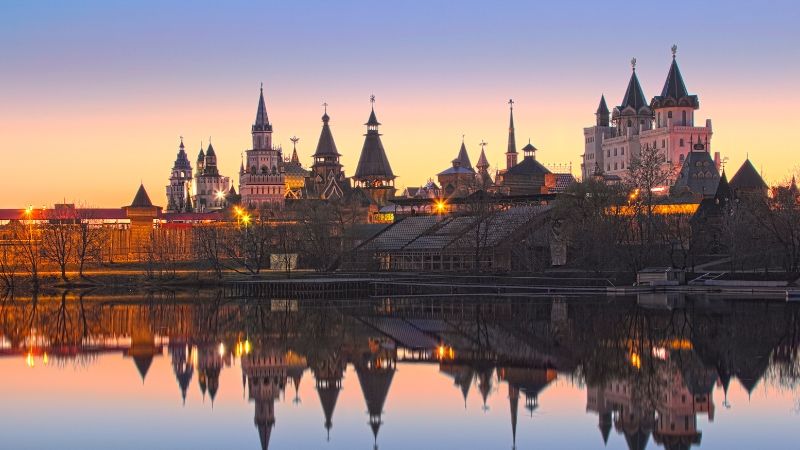In Russian culture, greetings are not just a formality; they are an essential part of social interaction that reflects respect and warmth.
As someone who has immersed myself in the Russian language and culture, I've come to appreciate the nuances of greetings that go beyond mere words. From the formal “Здравствуйте” (Zdravstvuyte) to the more casual “Привет” (Privet), each greeting carries its own significance and context.
In this article, we will explore the essential Russian greetings you need to know, how they differ in formal and informal settings, and some common mistakes to avoid!

1. Basic Russian Greetings

In Russian, greetings play a crucial role in setting the tone for communication. Here are some essential Russian greetings along with their usage:
1. Hello (Здравствуйте - Zdravstvuyte)
“Здравствуйте” is the formal way to say hello in Russian. It is typically used in professional settings, when meeting someone for the first time, or when addressing someone older or in a position of authority. This greeting conveys respect and politeness, making it suitable for a variety of formal contexts.
2. Hi (Привет - Privet)
“Привет” is the informal equivalent of hello and is used among friends, family, or peers. You would use this greeting when you’re comfortable with someone and wish to create a relaxed atmosphere. It’s a friendly way to start a conversation and is very common in casual settings.
3. Good Morning (Доброе утро - Dobroye utro)
“Доброе утро” is used to greet someone in the morning. It’s appropriate to use when you see someone for the first time that day, whether in a formal or informal context. This greeting helps to create a positive start to the day and shows consideration for the other person.
4. Good Afternoon (Добрый день - Dobryy den')
“Добрый день” is the greeting used in the afternoon, typically from around noon until early evening. Like “Доброе утро,” it can be used in both formal and informal situations, making it versatile for various social interactions.
5. Good Evening (Добрый вечер - Dobryy vecher)
“Добрый вечер” is used to greet someone in the evening, usually after 5 or 6 PM. This greeting, too, can be employed in both formal and informal contexts, signifying a respectful acknowledgment of the other person as the day winds down.
6. Goodbye (До свидания - Do svidaniya)
“До свидания” is the standard way to say goodbye in Russian. It is formal and can be used in almost any context, whether you are leaving a meeting or parting ways with friends. It literally translates to “until we meet again,” implying a sense of future connection.
7. See You Later (Увидимся - Uvidimsya)
“Увидимся” is a more casual way to say goodbye, meaning “see you later.” This phrase is often used among friends and acquaintances and conveys a sense of familiarity and expectation of meeting again soon. It’s a great way to leave a conversation on a friendly note.
2. Informal Russian Greetings Among Friends

When you’re among friends or in a casual setting, Russian greetings can become more relaxed and playful. Here are some informal greetings you can use:
1. How's it Going? (Как дела? - Kak dela?)
“Как дела?” is a friendly and informal way to ask someone how they are doing. This phrase can be used with friends, family, or anyone you have a casual relationship with. It invites the other person to share a bit about their day or current situation, making it a great way to kick off a conversation. A typical response might be “Хорошо, спасибо!” (Khorosho, spasibo!), meaning “Good, thank you!”
2. What's Up? (Что нового? - Chto novogo?)
“Что нового?” translates to “What’s new?” and is another informal greeting used among friends. This expression is perfect for catching up, as it encourages the other person to share any updates or news in their life. It's a light-hearted way to initiate conversation and express interest in what’s happening with your friends.
3. Long Time No See (Давненько не виделись - Davnen'ko ne videlis')
“Давненько не виделись” means “Long time no see” and is used when you haven’t seen someone for a while. This phrase conveys a sense of familiarity and warmth, making it a great way to reconnect with friends after a period apart. It can also lead to discussions about what each person has been up to since the last meeting.
Read Also:

3. Greetings In Different Contexts

Understanding the context in which you use greetings in Russian is essential for effective communication. Here’s how greetings vary between formal and casual settings, as well as some cultural nuances to keep in mind.
Formal Settings (Business, Introductions)
In formal settings, such as business meetings or official introductions, it’s important to use respectful language and body language.
- Greetings: Use “Здравствуйте” (Zdravstvuyte) when meeting someone for the first time or addressing someone in a position of authority. Pair this greeting with a firm handshake, which is customary in Russian business culture.
- Introductions: When introducing yourself or others, a polite greeting followed by your name is standard. For example, “Здравствуйте, меня зовут [Your Name]” (Hello, my name is [Your Name]).
- Eye Contact: Maintaining eye contact while greeting is seen as a sign of confidence and sincerity.
Casual Settings (Among Friends, Family)
In casual settings, greetings become much more relaxed and friendly.
- Greetings: Use informal greetings like “Привет” (Privet) or “Как дела?” (Kak dela?) when greeting friends or family. These expressions convey warmth and familiarity.
- Body Language: Hugs and light touches on the arm or shoulder are common among close friends and family. A smile or a casual wave can also accompany your greeting.
- Tone: The tone of voice is more relaxed, and it’s common to share a laugh or express enthusiasm when meeting friends.
Cultural Nuances in Greetings
Understanding the cultural nuances behind greetings can help you navigate social interactions more smoothly:
- Handshakes: A firm handshake is a common greeting in both formal and informal contexts. It’s polite to wait for the other person to initiate the handshake, especially in formal situations.
- Hugs: Among friends, hugs are a common way to greet each other, especially if you haven’t seen each other for a while. However, it’s best to gauge the other person’s comfort level before initiating a hug.
- Personal Space: Russians may stand closer than people from some Western cultures when conversing. This closeness can convey warmth and friendship.
- Politeness: Always use polite forms of address when greeting elders or those in authority. Using “вы” (vy) instead of “ты” (ty) shows respect and formality.
4. Special Greetings For Different Occasions
In addition to everyday greetings, Russians have specific phrases for various special occasions. Here are some common greetings you can use to celebrate significant events:
1. Happy Birthday (С днём рождения - S dnyom rozhdeniya)
“С днём рождения” is the traditional way to wish someone a happy birthday in Russian. This phrase is commonly used among friends, family, and colleagues. When greeting someone on their birthday, it’s also customary to give a small gift or card to show your appreciation. You might also hear variations such as “Поздравляю с днём рождения!” (Pozdravlyayu s dnyom rozhdeniya!), meaning “Congratulations on your birthday!”
2. Merry Christmas (С Рождеством - S Rozhdestvom)
“С Рождеством” is used to wish someone a Merry Christmas. This greeting is typically exchanged among family and friends during the holiday season, especially on December 25th for those celebrating in line with Western traditions or January 7th for those following the Orthodox calendar. It’s common to accompany this greeting with warm wishes for health and happiness in the coming year. Many people may also share traditional holiday meals or participate in festive activities.
3. Happy New Year (С Новым годом - S Novym godom)
“С Новым годом” is the phrase used to wish someone a Happy New Year. In Russia, New Year’s Eve is one of the most celebrated holidays, often marked with family gatherings, feasting, and fireworks. When exchanging this greeting, people often express their hopes for prosperity and joy in the new year. It’s also common to give small gifts or toasts during New Year celebrations, making this greeting an essential part of the festivities.
Read Also:

5. Common Mistakes To Avoid When Greeting In Russian
When learning Russian greetings, it's essential to be aware of potential pitfalls that could lead to misunderstandings or offend someone. Here are some common mistakes to avoid:
Misusing Formal/Informal Greetings
1. Using Informal Greetings in Formal Settings: One of the most significant mistakes learners make is using casual greetings like “Привет” (Privet) in formal situations, such as business meetings or when addressing elders. This can come off as disrespectful. Always opt for “Здравствуйте” (Zdravstvuyte) or “Добрый день” (Dobryy den') in formal contexts.
2. Switching Between Formal and Informal Incorrectly: When transitioning from a formal to an informal relationship, it’s essential to gauge when it’s appropriate to switch greetings. If you’re unsure, it’s best to continue using formal greetings until invited to do otherwise.
3. Overusing Formal Greetings: Conversely, consistently using formal greetings in casual settings can create distance and make interactions feel stiff. It’s crucial to adapt your greeting style to the relationship and context to foster friendliness and warmth.
Cultural Faux Pas in Greetings
1. Ignoring Personal Space: While Russians may stand closer during conversations, invading personal space can make others uncomfortable. Pay attention to body language and maintain a respectful distance, especially when meeting someone for the first time.
2. Handshakes and Greetings: In Russian culture, handshakes are customary, but it’s important to note that a firm handshake should be initiated by the other person. Avoid reaching out for a handshake unless you’re certain it’s appropriate. Additionally, it’s polite to shake hands with everyone present when entering a room.
3. Using First Names Too Soon: In Russia, it’s generally considered impolite to use someone's first name without their permission, especially in formal settings. Always address people by their surname and use the appropriate title (Mr./Ms.) until you are invited to use their first name.
4. Hugging Without Consent: While hugs are common among friends, initiating a hug with someone you don't know well can be perceived as too familiar. Wait for the other person to extend their arms for a hug or gauge their comfort level before proceeding.
5. Overlooking Greeting Etiquette: Russians often expect to exchange greetings before diving into conversation, even in casual situations. Failing to acknowledge someone with a greeting can be seen as rude. Always take a moment to greet others before starting discussions or inquiries.
Conclusion
To wrap things up, we’ve covered the basics of Russian greetings, from the formal “Здравствуйте” to the casual “Привет,” along with special phrases for occasions like birthdays and New Year. Knowing when and how to use these greetings can really help you connect with Russian speakers and make conversations feel more genuine.
If you want to dive deeper into the Russian language and culture, I suggest checking out Lingopie! It’s a fun platform where you can watch TV shows and movies in Russian, helping you practice your listening skills and pick up everyday phrases, including greetings, in real conversations.
So, why not give Lingopie a try? Explore its content and take your Russian to the next level!








![Russian Alphabet: Everything You Need to Know [2025]](/blog/content/images/size/w300/2025/04/Russian-alphabet-.jpg)

